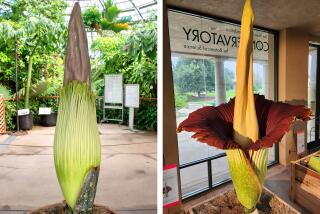Plant It Black
- Share via
Gothic hausfrau morticia addams used to lop the buds off her scarlet roses. If they’d been black, would she have bothered? Not on your tombstone.
Flowers in funereal shades can haunt a garden like bats. You feel their presence before you spot them: inky pansies along a path, a swarm of ‘Superstition’ iris, ‘Queen of the Night’ tulips, the scabiosa ‘Ace of Spades.’ In contrast to more conventional, sunny flower colors, midnight purples and maroons stop the wandering eye cold. They’re “luxurious, complicated, secretive and slightly decadent,” says L.A. garden designer Chris Rosmini, who grows a plot of black blooms at her Highland Park house. Rosmini, widely known for the subtle tapestries of her perennial borders, mixes smoky dahlias, violas, mondo grass and a dark-flowering sage (Salvia discolor) with silver or bronze-leafed plants, all in view of a path or bench. “The blacks disappear with distance,” she observes. “They need to be seen up close, in either a small garden or a pot, where you can set them off with pale apricots and yellows.”
For her, the near-black experience is more about texture than actual color: “The darker the flower, the more clearly you see its surface--the stained-glass sheen on an iris, the velvet of pansies.”
While a white garden shines at night, Rosmini says a medley of shadow tones emerges in “crepuscular light--early evening, early morning.” At high noon, like vampires, black blooms assume the crumpled look of rags.
They’re not for everyone, of course, though more and more black flowers have appeared in nurseries by popular demand: hollyhocks, gladioli, snapdragons, daylilies--deep, dark blooms with names like ‘Black Knight,’ ‘Black Prince,’ ‘Black Magic.’ And yes, Morticia, at last, even roses have gotten blacker.
*
Three good mail-order sources for black flowers are: Thompson & Morgan, (800) 274-7333; Van Bourgondien, (800) 622-9997; and Wayside Gardens, (800) 845-1124.






